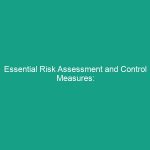Introduction
Good morning team! Today, we’re going to discuss a crucial aspect of our Workplace Safety: the Essential Working at Elevations Guidelines. As many of you know, working at heights presents unique challenges and risks that we must address to ensure everyone’s Safety. Understanding these guidelines not only protects you but also your coworkers and our overall work Environment.
It’s vital to recognize that Safety is not just a regulatory requirement; it’s a shared responsibility that we all have to prioritize. So, let’s dive into why adhering to these elevation safety practices is important and how we can effectively implement them in our daily operations.
Understanding Essential Working at Elevations Guidelines
The Essential Working at Elevations Guidelines are a set of protocols and Safety Measures designed to protect employees who perform tasks at heights. This includes jobs such as construction, maintenance, and any other activities requiring ladders, scaffolding, or aerial lifts.
These guidelines are crucial because falls from heights are among the leading causes of workplace injuries and fatalities. According to OSHA, falls account for approximately 33% of all construction-related deaths. By adhering to these guidelines, we can reduce the risk of these incidents and promote a safer working environment.
A common misconception is that only experienced workers need to follow these guidelines. However, every team member, regardless of experience, must be aware of and adhere to elevation safety practices to prevent accidents and injuries.
Key Hazards, Risks, and Safety Considerations
When working at elevations, several Hazards can pose significant risks to your safety. Here are some of the most critical:
- Falls: The most obvious and prevalent risk when working at heights.
- Structural Failures: Weak or improperly erected scaffolding or platforms can collapse.
- Slips and Trips: Uneven surfaces or debris can lead to accidents.
- Weather Conditions: Wind, rain, or snow can make working at heights more dangerous.
- Equipment Failure: Malfunctioning safety equipment or tools can lead to accidents.
Ignoring safety protocols can have severe consequences, including serious injuries or even fatalities. For example, a worker might slip from a ladder due to improper footwear, leading to a fall that could have been prevented with the correct Safety Measures in place.
Best Practices, Procedures, & Actionable Advice
Now that we understand the hazards, let’s discuss Best Practices to mitigate these risks:
1. Use Proper Personal Protective Equipment (PPE)
Always wear appropriate PPE, including hard hats, harnesses, and non-slip footwear. Ensure your harness is properly fitted and inspected before each use.
2. Conduct Regular Safety Training
Participate in ongoing safety training sessions. This will help reinforce the importance of safety measures and keep everyone informed about new protocols and equipment.
3. Inspect Equipment Thoroughly
Before starting any job at heights, inspect all equipment, including ladders, scaffolding, and harnesses, to ensure they are in good working condition. Report any defects immediately.
4. Follow Safe Work Practices
Stick to the recommended guidelines for ladder and scaffold use:
- Ensure ladders are placed on stable surfaces and at the correct angle.
- Never exceed the load limit of ladders and scaffolding.
- Use guardrails on scaffolding whenever possible.
5. Be Aware of Weather Conditions
Always check the weather before working at heights. If conditions are unfavorable, such as high winds or rain, postpone the work until it is safe to proceed.
6. Communicate Effectively
Maintain clear communication with your team. Use hand signals or radios to ensure everyone is aware of movements and potential hazards.
7. Report Unsafe Conditions
If you observe unsafe conditions or practices, report them to a supervisor immediately. Remember, safety is everyone’s responsibility.
Regulations, Standards, and Compliance
Adhering to safety Regulations is not just good practice; it is a legal requirement. The Occupational Safety and Health Administration (osha) has established comprehensive Standards for working at heights:
- OSHA 1926.501: Duty to have Fall Protection.
- OSHA 1926.502: Fall protection systems criteria and practices.
- OSHA 1926.503: Training requirements.
Compliance with these standards is critical not only for legal reasons but also for the safety and well-being of all employees. Regular audits and training sessions help ensure that we remain compliant and prepared.
Employee Engagement & Discussion
Now that we’ve covered the essential guidelines, let’s take a moment for discussion. Here are some questions to consider:
- What specific safety challenges have you encountered while working at heights?
- Are there any additional safety measures you believe could enhance our current practices?
- How do you feel about the current training programs? Are they effective?
Your input is valuable in creating a safer work environment. Feel free to share your thoughts and experiences with the team.
Conclusion & Key Takeaways
In conclusion, the Essential Working at Elevations Guidelines are vital for ensuring safety while working at heights. By understanding the hazards, following Best Practices, and complying with regulations, we can significantly reduce the risk of accidents and injuries.
Remember, it’s crucial to apply these safety practices daily. Your safety, and that of your colleagues, is our top priority. Thank you for your attention and commitment to making our workplace safer. Let’s keep the conversation going and ensure that safety always comes first!


